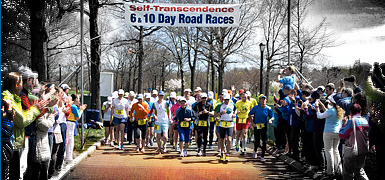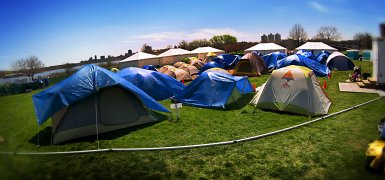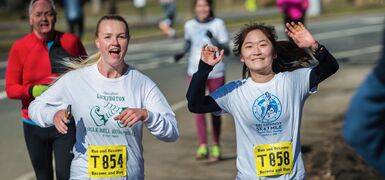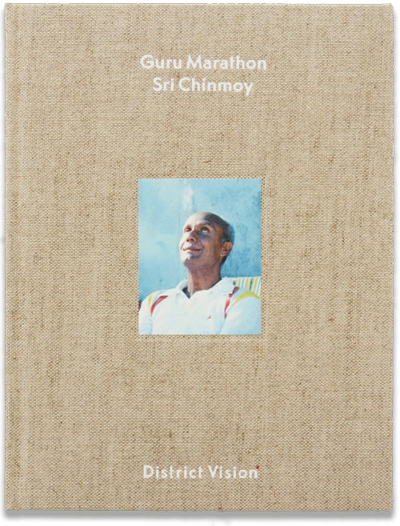10th Annual Self-Transcendence Ten Day Race
8th Annual Self-Transcendence Six Day Race
The Sri Chinmoy Marathon Team is proud to sponsor the Tenth Annual Self-Transcendence Ten Day Race and the Eighth Annual Self-Transcendence Six Day Race. This year there are over 50 runners from 15 nations, making it a truly international event. These races are a test of a runners' endurance, skill with pacing, and ability to recover from the stress of constantly moving. The competitors run with minimal sleep, all the while trying to accumulate as many miles as possible. This event is akin to the old six day endurance events held in the latter part of the 19th century, popularly known as 'pedestrianism'. Those races were held on indoor short tracks made of compressed earth and tree bark or sawdust. The athletes would run in a style known as 'go as you please'- they could run or walk around the clock. Nearly 100 years before the six-day races were in their heyday, attempts at 1000 miles within a 20 day time frame had been undertaken by highly trained professional walkers, with large amounts of money waged on their outcomes. Most of these contests were solo events in which a walker would cover one mile each hour for 1000 consecutive hours.Tremendous amounts of money was waged on the walkers ability to survive these events. Because so few of these contests were competitive, it took nearly a century before larger fields and more do-able events like the six-day became popular. Great athletes of the 1880's began to push the totals up to 600 miles covered in six days. British runner George Littlewood peaked the event at 623 miles in 1888. At the beginning of the Twentieth century, pedestrianism died out, as promoters either lost money or their enthusiasm. The six day event was revived in the early 1980's as ultramarathoning followed on the heals of marathon fever and the running boom of the 1970's. Yiannis Kouros of Greece holds the current road record of 639 miles, set in 1988 at Flushing Meadows.
The Sri Chinmoy Marathon Team held a 1000 mile race in the spring of 1985, and later in the year held the first Sri Chinmoy Five Day Race at Flushing Meadow Park in Queens, which lasted for three consecutive years and led to the Seven Day Race, the forerunner of today's' Ten Day event. The first Five Day Race featured 15 competitors as did the first Seven Day Race. By 1995 the longer event grew to 34 starters. The quality of the competitions and performances has been outstanding considering that a race of this length is usually a test of individual survival. In the inaugural Seven Day Race in 1988, Marty Sprengelmeyer of Davenport,Iowa narrowly beat women's winner Suprabha Beckjord of Washington,DC. 527 miles to 521 miles. In 1990 ultra legend Al Howie set a new record of 530 miles. The following year Charlie Eidel of Gardiner, NY ran 550 miles for a new course record, while Suprabha Beckjord ran 523 miles to claim the women's record again. Suprabha won the Seven Day five times for the ladies. In 1994 Antana Locs of Canada won the Seven Day overall with 518 miles. Georgs Jermolajevs came all the way from Latvia to win the Seven Day Race in 1995, in record-setting fashion, running 578 miles, while England's Pippa Davis finally laid claim to the women's title as she ran 525 miles. In the 1996 inaugural Ten Day Race, Georgs Jermolajevs again fashioned a victory with 725 miles, but was hard pressed by Dipali Cunningham of Australia, who garnered 723 miles for the ladies. In a smaller field in 1997 veteran Donald Winkley of Corpus Christi,Texas prevailed with 530 miles.
In 1998, Istvan Sipos of Hungary escaped with a narrow victory over Georgs Jermolajevs by 670 miles to 669 in a rain-filled ten days. Sipos would later shock the extreme running world with a great victory in the Sri Chinmoy 3100 Mile Race only a month later, running this distance in a remarkable 46 days, 17 hours. In the inaugural Sri Chinmoy Six-Day Race, David Luljak of the USA emerged victorious with 541 miles, and Dipali Cunningham broke Sandy Barwick's world road best with 504 miles. In 1999 Ron Gehl from Ontario,Canada prevailed with 640 miles in the 10-Day race, and Rimas Jakelaitis from Lithuania emerged victorious in the Six-day with 517 miles. Elvira Janosi and Dipali Cunningham won respectively for the women. In 2000 Rimas Jakelaitis set a new course record of 745 miles in the Ten day, David Luljak from Chevy Chase,MD took top honors in the Six day with 502 miles, and ultra pioneer and legend Ted Corbitt, 81, set a new world age group(80-84) best completing 240 miles in the six day event. Janosi and Cunningham again repeated as ladies' winners. 2001's races produced amazing results. Rimas Jakelaitis won the Ten Day in an astounding 901 miles, including a remarkable split of 600 miles for six days, only the fifth man this century to reach that plateau. Jakelaitis' total of 901 miles is the second best total for ten days all time. Dipali Cunningham broke her own world road best and prevailed in the Six Day Race overall, with 510 miles. Lastly Ted Corbitt shattered the octogenarian record with 303 miles in six days(80-84 age group), a mark that may not be broken for another generation or two. The two multidays moved back to Flushing Meadows Corona Park in 2002. Rimas Jakelaitis repeated again with 701 miles, Ashprihanal Aalto emerged victorious in the Six Day with 422 miles, and Dipali Cunningham won for the fifth straight time with 415 miles. In 2003, Hubert Muckenhumer of Austria prevailed with 631 miles in the Ten Day, as well as Dorothea Voegeli of Switzerland leading the women with 577 miles. Ashprihanal Aalto of Finland won the Six Day race for the second straight year with 457 miles, while Dipali Cunningham remained undefeated in the six Day race with 442 miles.
The Ten Day event shares its horizons with the 1300, 1000, and 700 mile running races collectively known as the Sri Chinmoy Ultra Trio that are held in the fall each year. A runner has 12 or 13 days to complete 700 miles, 15 or 16 days to finish 1000 miles, or 18 or 19 days to complete 1300 miles.
The world's best distances for 10 days on the road are 964 miles (in 1988) by Yiannis Kouros of Australia who was then a Greek national, and 807 miles (in 1991) by Sandy Barwick of New Zealand. The Six-Day Race, which starts on April 29, is currently the only six-day event in North America. Yiannis Kouros holds the road best for six days at 639 miles, set in 1988; Dipali Cunningham ran 510 miles for six days in a stunning performance in 2001, winning the race overall.
The runners eat, sleep and rest at trackside and receive care around the clock in their efforts to bring forward their best physical capacities. They circle the one mile loop course and often run 20 hours in any given 24 hour period. They are truly pioneers in a sport still obscure to the perceptions of the public. But their stories are told by their feet and their hearts.
The Sri Chinmoy Marathon Team offers its gratitude to the New York City Department. of Parks and Recreation and the staff of Flushing Meadows Corona Park,(Adrian Benepe, Parks Commissioner; Estelle Cooper, Flushing Meadows Park Director; Richard Murphy, head of Borough of Queens Parks) for allowing this event to happen; to City Councilman James Genarro for his support and assistance; to the courageous runners who are embarking on this journey of self- exploration, to the many SCMT volunteers who give so lovingly of their time, and to the leader and inspiration of all of the SCMT events, Sri Chinmoy himself, who has so strikingly nurtured multiday racing here in New York the past eighteen years. May all athletes transcend their previous achievements.




